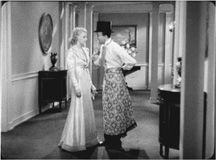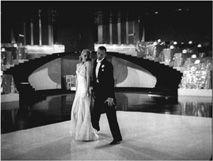B0041VYHGW EBOK (140 page)
Authors: David Bordwell,Kristin Thompson


9.22 After losing his suit in a card game, Lucky still wears his top hat in
Swing Time.

9.23 Astaire and Rogers dance in the art deco nightclub set.
Despite its backstage settings and show business plot,
Swing Time
sets some numbers in an everyday environment. When Lucky visits Penny’s apartment, he sings “The Way You Look Tonight” as she shampoos her hair—using a convenient piano in her apartment to accompany himself (though a nondiegetic orchestra plays along as well). When the couple visits the snowy countryside, however, there is no diegetic accompaniment at all within the locale as they sing “A Fine Romance”—only an unseen orchestra. As we are reminded over and over in musicals, this world makes it possible for people, at any time and in any place, to express themselves through song and dance.
In studying film, we often need to make explicit some things we ordinarily take for granted—those assumptions so fundamental that we no longer even notice them. Genres, along with more basic types of film such as fiction and documentary, animation and live action, on mainstream and experimental film, are such taken-for-granted categories. At the back of our minds whenever we watch a film, these categories shape what we expect to see and hear. They guide our reactions. They press us to make sense of a movie in certain ways. Shared by filmmakers and viewers alike, these categories are a condition for film art as we most often experience it.
Yet there are other kinds of films than live-action fictional features. There are other modes of filmmaking, that, as we saw in
Chapter 1
, depend on ways in which the films are made and the intentions of the filmmakers. The most common are documentary, experimental, and animated cinema, and we’ll examine these in the next chapter.
One of the most common ways in which we approach films is by type, or genre. Genres are ways of classifying films that are largely shared across society, by filmmakers, critics, and viewers. Films are most commonly grouped into genres by virtue of similar plot patterns, similar thematic implications, characteristic filmic techniques, and recognizable iconography.
When trying to characterize a film genre, you can ask such questions as these:
- Before you saw the film, did you know what genre it belonged to? What factors in advance or publicity conversation gave you hints?
- What conventions in the film signal its genre? How do those conventions function? Do they allow storytelling to be more rapid and economical? Do they aim to arouse strong emotional responses?
- What genre innovations, if any, can you find in the film? A good way to determine these is to ask if your expectations were thrown off by some developments in the film.
- Does this film seem to be combining conventions from more than one genre? If so, how does it make the genre elements compatible? Do innovative aspects of the film depend on the genre mixing?
WHERE TO GO FROM HERE
The conception of a genre’s social function as ritual (p.
336
) derives from the anthropological theory of Claude Lévi-Strauss. One version of the ritual model is Thomas Schatz,
Hollywood Genres
(New York: Random House, 1981). See also Jane Feuer,
The Hollywood Musical
(London: British Film Institute, 1982), and Rick Altman,
The American Film Musical
(Bloomington: Indiana University Press, 1987). Altman refined and elaborated on his views in his
Film/Genre
(London: British Film Institute, 1999), which examines many issues relating to genre theory.
Another conception of a genre’s social function holds that genre films are centrally concerned with social groups—particularly women and racial minorities—that are oppressed and feared by many in a society. The genre’s stories and iconography portray those groups as threatening the majority’s way of life. The film’s action will then work to contain and defeat these elements. One argument for this approach can be found in Robin Wood, “An Introduction to the American Horror Film,” in Bill Nichols, ed.,
Movies and Methods,
vol. II (Berkeley: University of California Press, 1985), pp.
195
–220. For a criticism of this otherness theory, see Noël Carroll’s
The Philosophy of Horror; or, Paradoxes of the Heart
(New York: Routledge, 1990), pp.
168
–206.
For a survey of approaches to genre, as well as an analysis of several Hollywood genres, see Steve Neale,
Genre and Hollywood
(London: Routledge, 2000). A variety of approaches is represented in Wheeler Winston Dixon, ed.,
Film Genre 2000: New Critical Essays
(Albany: State University of New York Press, 2000).
The vast array of conventions in the Western genre have been codified, along with major films and figures, in two useful reference books: Phil Hardy, ed.,
The Western
(London: Aurum, 1991), and Edward Buscombe, ed.,
The BFICompanion to the Western
(New York: Atheneum, 1988). Our discussion of the conventions of the Western has been shaped by John Cawelti’s
The Six-Gun Mystique
(Bowling Green, OH: Bowling Green Popular Press, 1975). Howard Hughes summarizes one subgenre of the Western in
Spaghetti Westerns
(Harpenden, England: Pocket Essentials, 2001.)
Noël Carroll explores the affective aesthetics of the horror film in
The Philosophy of Horror,
cited above. Carroll’s analysis, which has guided our discussion of the genre, is complemented by Cynthia A. Freeland’s
The Naked and the Undead: Evil and the Appeal of Horror
(Boulder, CO: Westview Press, 2000) and by the social account offered by Andrew Tudor’s
Monsters and Mad Scientists: A Cultural History of the Horror Movie
(Oxford: Blackwell, 1989). Phil Hardy, ed.,
Horror
(London: Aurum, 1985), is a comprehensive reference book.
For a general history of the American musical, see Ethan Mordden,
The Hollywood Musical
(New York: St. Martin’s Press, 1981). Essays on specific topics are included in Rick Altman, ed.,
Genre: The Musical
(London: Routledge & Kegan Paul, 1981).
A survey of early Hollywood musicals that deals with the revue musicals and the more narratively oriented films of the 1930s is Richard Barrios’s
A Song in the Dark: The Birth of the Musical Film
(New York: Oxford University Press, 1995). One of the most important production units concentrating on musicals, run by Arthur Freed, is discussed in Hugh Fordin,
The World of Entertainment: The Freed Unit at MGM
(New York: Doubleday, 1975).
Swing Time
is among the films discussed in Hannah Hyam’s
Fred and Ginger: The Astaire–Rogers Partnership 1934–1938
(Brighton: Pen Press, 2007).
www.filmsite.org/genres.html
A wide-ranging discussion of a great many genres, including historical summaries and key examples.
www.lewestern.com/US/1PresentationUS.htm
A database devoted to the Western, with information in both French and English.
www.carfax-abbey.com
A database of classic and contemporary horror films, with over 150 links to other sites.
Recommended DVD Supplementswww.musicals101.com/index.html
A reference site for musical theater and cinema.
Westerns
“The Making of
Silverado
” is in some ways a conventional “making-of” documentary, with sections on rehearsal, storyboards, editing, cinematography, set design, and so on. Yet the overall emphasis is on the film as a Western. Director Lawrence Kasdan tried to revive the classic Western and to pay homage to it at the same time. Interviews with cast and crew reveal the film’s techniques, but they often discuss how film form and style worked in service of the old-fashioned Western’s conventions. “The Making of
Butch Cassidy and the Sundance Kid
” contains an amount of footage unusual for a late 1960s promotional documentary. It also avoids the mutually congratulatory tone of many supplement interviews, with director George Roy Hill giving a warts-and-all account of the production of this classic Western.
“A Turning of the Earth: John Ford, John Wayne, and
The Searchers
” combines accounts by the participants, contemporary footage of the production, and expert analysis of the film. A biographical overview of one of the major directors of Westerns is “Budd Boetticher—an American Original,” on the DVD of one of his classic films,
Seven Men from Now.
Other interesting discussions of Westerns include “Sir Christopher Frayling on
The Magnificent Seven
” and “Leone’s West” (
The Good, the Bad, and the Ugly
).
In “An Epic Explored,” director James Mangold talks about making
3:10 to Yuma
in an era when Westerns are rare. The same disc has a short but information-packed documentary on the film’s production, including rarely discussed topics like a gun that fires dust pellets to simulate bullet strikes. The three documentaries about
Once upon a Time in the West
actually add up to one making-of of just over an hour. Other directors analyze Leone’s style, and there is much discussion of the film’s place in the Western genre.
“Inside the Labyrinth,” though primarily a making-of for
The Silence of the Lambs,
includes considerable discussion of it as a horror or thriller film. Similarly, the making-of “Behind the Scream,” on
Scream,
discusses horror-film conventions.
A brief making-of featurette on
Rosemary’s Baby
discusses it as “the great horror film without any horror in it,” stressing its lack of special effects and its dependence on suggestion rather than explicit displays of the film’s monstrous elements.
Quite possibly the most extensive DVD supplement dealing with a horror film is “The Making of
The Frighteners,
” a 4½-hour documentary directed by Peter Jackson that deals with every aspect of the production—including a tour of the tiny Weta Digital facility that would later expand exponentially for
The Lord of the Rings.
Both
Hellboy
and
Hellboy II: The Golden Army
have making-of documentaries that emphasize the monsters used in each. The second movie famously featured 32 types of monsters, created through a wide range of means, from elaborate puppets and costumes to computer-generated creatures.
“Musicals Great Musicals: The Arthur Freed Unit at MGM,” included on the
Singin’ in the Rain
DVD, chronicles the golden era of musical production at the studio that also made
The Wizard of Oz, The Band Wagon, Meet Me in St. Louis,
and other classics. Excerpts from MGM musicals made in the early years of sound make this an exemplary historical survey. The DVD also includes a charming supplement, “What a Glorious Feeling,” on the making of
Singin’ in the Rain.
“More Loverly Than Ever:
My Fair Lady
Then and Now,” a 1994 documentary dealing not only with the film’s history but with its restoration, points out that the film came at the end of a cycle of big-budget adaptations of Broadway musicals.
The “Behind the Music” supplement for
Saturday Night Fever
discusses that enormously popular film’s innovations, including central characters who dance but don’t sing. It traces how a musical subgenre, in this case arising from the short-lived disco fad of the 1970s, can experience a cycle of sudden success and equally sudden decline.
In “The Nightclub of Your Dreams: The Making of
Moulin Rouge!
” Nicole Kidman talks about singing live during filming rather than the usual lip-synching to a song’s playback. There is also a segment on the choreography.